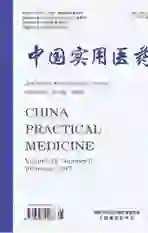肥胖与绝经前乳腺癌临床相关性分析
2017-03-28李强苏艳玲
李强+苏艳玲



【摘要】 目的 收集绝经前乳腺癌患者的临床病理资料, 探讨肥胖与绝经前乳腺癌临床病理特征之间的关系。方法 117例绝经前乳腺癌患者, 采用免疫组化法(IHC)检测ER表达, 测量身高体重并计算体质量指数(BMI)数值, 分析BMI值及腹型肥胖与临床病理特征之间的相关性。结果 117例绝经前乳腺癌患者年龄28~54岁, 中位年龄47岁, 年龄>38岁者78例(66.67%), 肿瘤大小>2 cm者71例(60.68%), 伴淋巴结转移者68例(58.12%), 远处转移者25例(21.37%), BMI>23.5 kg/m2者60例(51.28%), 伴腹型肥胖者58例(49.57%)。研究表明, 患者BMI值及腹型肥胖均与肿瘤大小密切相关(P<0.05), 而与患者年龄、淋巴结转移、远处转移及ER表达等无关(P>0.05)。利用Logistic回归模型对肥胖与乳腺癌临床病理特征的相关性进行分析, 显示较高BMI值和腹型肥胖因素是影响肿瘤大小的独立因素(P<0.05)。结论 高BMI及腹型肥胖是影响绝经前乳腺癌肿瘤大小的危险因素。
【关键词】 绝经前乳腺癌;体重指数;腹型肥胖
DOI:10.14163/j.cnki.11-5547/r.2017.05.002
Analysis of clinical correlation between obesity and premenopausal breast cancer LI Qiang, SU Yan-ling. Department of Medical Oncology, Shenzhen Hospital of Chinese Academy of Medical Sciences Tumor Hospital, Shenzhen 518000, China
【Abstract】 Objective To collect clinical pathological data of premenopausal breast cancer patients, and to investigate relationship between obesity and clinical pathological characteristics of premenopausal breast cancer. Methods A total of 117 patients with premenopausal breast cancer received immunological histological chemistry (IHC) for ER expression detection. Their height and weight were measured to calculate body mass index (BMI). Correlation between BMI, abdominal obesity and clinical pathological characteristics was analyzed. Results The 117 patients with premenopausal breast cancer had age range as 28~54 years old, with median age as 47 years old. There were 78 cases > 38 years old (66.67%), 71 cases with tumor > 2 cm (60.68%), 68 cases with lymphatic metastasis (58.12%), 25 cases with distant metastasis (21.37%), 60 cases with BMI >23.5 kg/m2 (51.28%), and 58 cases with abdominal obesity (49.57%). Research showed close correlation between BMI, abdominal obesity and tumor size (P<0.05), while there was no correlation between BMI, abdominal obesity and age, lymphatic metastasis, distant metastasis and ER expression (P>0.05). Logistic regression model in correlation analysis of obesity and clinical pathological characteristics of breast cancer showed high BMI and abdominal obesity as the independent influencing factors for tumor size (P<0.05). Conclusion High BMI and abdominal obesity are the risk factors which influence tumor size of premenopausal breast cancer.
【Key words】 Premenopausal breast cancer; Body mass index; Abdominal obesity
乳腺癌是女性最常見的一类恶性肿瘤, 其发病率和死亡率在女性肿瘤中均居于前列[1]。绝经前乳腺癌表现出较为特殊的发生、发展和预后特征, 此类患者群体更值得关注[2, 3]。体内雌激素代谢紊乱会导致肥胖, 而肥胖也在促进乳腺癌的发生发展过程中起到重要作用[4, 5]。迄今有关肥胖与绝经前乳腺癌患者群体临床相关性研究尚存争议[6] 。本研究旨在初步探讨117例绝经前乳腺癌患者的临床病理特征与肥胖因素的相关性, 为进一步研究绝经前乳腺癌的生物学特性提供线索。
1 资料与方法
1. 1 一般资料 选取本院2014年1月~2016年9月收治的117例绝经前乳腺癌患者作为研究对象, 收集患者的相关临床病理资料, 测量腰腹围并计算BMI值。
1. 2 入组标准 117例患者均经病理学证实且病历资料完整, 排除肝肾疾病及其他妇科疾病, 术前未行化疗、放疗或内分泌治疗。绝经标准:①已切除双侧卵巢;②患者年龄≥60 岁;③患者年龄<60 岁, 血清中雌二醇和卵泡刺激素达到绝经后水平维持1年以上;④正在接受促黄体生成素释放激素(LH-RH) 类似物或激动剂治疗的患者和接受辅助性化疗的绝经前患者, 不能判断其是否绝经。
1. 3 ER表达测定方法 肿瘤组织标本病理切片送检, 采用免疫组化法检测组织ER表达情况。评定标准:ER的表达以细胞核内出现棕黄色颗粒为阳性细胞, 采用国内通用标准, 根据阳性细胞所占的百分数分级, >10%癌细胞着色为ER(+)、≤10%癌细胞着色为ER(一)。
1. 4 统计学方法 采用SPSS17.0统计学软件对数据进行统计分析。计量资料以均数±标准差( x-±s)表示, 采用t检验;计数资料以率(%)表示, 采用χ2检验。用Logistic回归进行组间多因素分析。P<0.05表示差异具有统计学意义。
2 结果
2. 1 临床特征描述分析 117例绝经前乳腺癌患者年龄28~54岁, 中位年龄47岁, 年龄>38岁者78例(66.67%), 肿瘤大小>2 cm者71例(60.68%), 伴淋巴结转移者68例(58.12%), 远处转移者25例(21.37%), BMI>23.5 kg/m2者60例(51.28%), 伴腹型肥胖者58例(49.57%)。见表1。
2. 2 肥胖与临床病理特征的关系 研究表明, 患者BMI值及腹型肥胖均与肿瘤大小密切相关(P<0.05), 而与患者年龄、淋巴结转移、远处转移及ER表达等无关(P>0.05)。全部患者中, 较高BMI值或腹型肥胖因素对肿瘤生长影响显著。见表2, 表3。
2. 3 影响肿瘤大小的多因素分析 利用Logistic回归模型对肥胖与乳腺癌临床病理特征的相关性进行分析。结果显示, 较高BMI值和腹型肥胖因素是影响肿瘤大小的独立因素(P<0.05)。见表4, 表5。
3 讨论
乳腺癌目前已成为全球女性最常见的恶性肿瘤之一, 其发病机制尚未完全阐明。研究表明, 乳腺癌具有雌激素依赖性, 体内雌激素水平的增高可明显增加乳腺癌的患病风险[7-10]。血清雌激素过量, 就会破坏乳腺组织的增生与修复平衡, 促进乳腺癌细胞的异常增殖与分化[8] 。绝经前乳腺癌患者体内雌激素水平较高, 而肥胖能促进雌激素的合成, 血清游离雌二醇水平随着BMI的增高而增加。近年来肥胖与绝经前乳腺癌的关系受到关注。
本研究以绝经前乳腺癌为研究对象, 通过对临床病理特征因素进行合理筛选, 较为客观地反映肥胖因素在肿瘤发生发展过程中的生物学特点。研究表明, BMI值及腹型肥胖因素与肿瘤大小关系密切, 而与患者年龄、淋巴结转移、远处转移及ER表达等无显著相关性。较高BMI值及腹型肥胖是影响肿瘤大小的危险因素。考虑肥胖促进绝经前乳腺癌患者体内雌激素合成, 导致血清雌激素代谢紊乱可能, 进一步影响乳腺癌的增殖生长。不过这些都有待于更多的临床研究去验证。
综上所述, 肥胖可显著增加乳腺癌患病的危险性, BMI值和腹型肥胖可能是绝经前乳腺癌肿瘤大小的独立风险因素。具有较高BMI值或腹型肥胖的绝经前乳腺癌患者, 其肿瘤大小及增殖受影响更为显著。提示肥胖所致的代谢紊乱可能是乳腺癌患病的原因。其确切的生物学机制尚未阐明, 也有待于扩大样本量进一步研究证实。
参考文献
[1] John EM, Sangaramoorthy M, Hines LM, et al. Body size throughout adult life influences postmenopausal breast cancer risk among hispanic women: the breast cancer health disparities study. Cancer Epidemiol Biomarkers Prev, 2015, 24(1):128-137.
[2] Munsell MF. Body mass index and breast cancer risk according to postmenopausal estrogen-progestin use and hormone receptor status. Epidemiologic Reviews, 2014, 36(1):114-136.
[3] Secreto G, Zumoff B. Abnormal production of androgens in women with breast cancer. Anticancer Research, 1994, 14(5B):2113-2117.
[4] Cleary MP. Impact of obesitty on development and progression of mammary tumors in preclnical models of breast cancer. Journal of Mammary Gland Biology & Neoplasia, 2013, 18(3-4):333-343.
[5] Tormey DC, Gray R, Gilchrist K, et al. Adjuvant chemohormonal therapy with cyclophosphamide, methotrexate, 5-fluorouracil, and prednisone (CMFP) or CMFP plus tamoxifen compared with CMF for premenopausal breast cancer patients. An Eastern Cooperative Oncology Group trial. Cancer, 1990, 65(2):200-206.
[6] Turkoz FP, Solak M, Petekkaya I, et al. The prognostic impact of obesity on molecular subtypes of breast cancer in premenopausal women. Journal of B.u.on. Official Journal of the Balkan Union of Oncology, 2013, 18(18):335-341.
[7] Palmer JR, Adams-Campbell LL, Boggs DA, et al. A prospective study of body size and breast cancer in black women. Cancer Epidemiology Biomarkers & Prevention, 2007, 16(9):1795-1802.
[8] Benedetto C, Salvagno F, Canuto EM, et al. Obesity and female malignancies. Bailli & Egrave Re S Best Practice & Research in Clinical Obstetrics & Gynaecology, 2015, 29(4):528-540.
[9] 林威, 唐錄英, 岑玉玲,等. 体重指数与谷氨酰半胱氨酸合成酶催化亚基基因多态性的交互作用对女性乳腺癌风险的影响. 中华流行病学杂志, 2013, 34(11):1115-1119.
[10] Anderson GL, Neuhouser ML. Obesity and the Risk for Premenopausal and Postmenopausal Breast Cancer. Cancer Prevention Research, 2012, 5(4):515.
